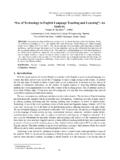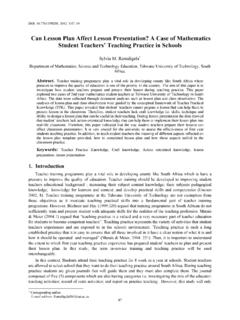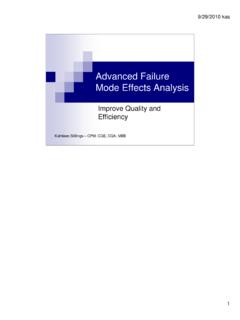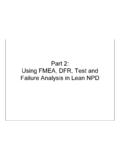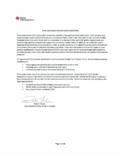Transcription of Critical Review of a Risk Assessment Method and its ...
1 Critical Review of a Risk Assessment Method and its applications Silvianita 1, Mohd. Faris Khamidi 2 and Kurian V. John 3 1 PhD Student in Civil Eng, Universiti Teknologi PETRONAS; Institut Teknologi Sepuluh Nopember 2 Dr in Civil Engineering Universiti Teknologi PETRONAS 3 Prof in Civil Engineering Universiti Teknologi PETRONAS Abstract. Risk is a complex issue with methods that are suitable for the decisions being made. Risk assessments tools are used for preparing a scientific basis to decrease the risk. There are several risk assessments tools and recently it is studied that the focus has been improved to the application of the integrated risk assessments tools. The tools currently used in risk assessments are HAZOP, FMEA, FTA and ETA. This paper studied the literature of the applications in various industries.
2 Related paper publishing in the international journals are collected and analyzed so that the two questions can be answered: (i) what Method of risk Assessment was currently used? (ii) do the currently used tools can be formulated into integrated risk Assessment tools? This paper not only explain evidence that the integrated risk Assessment tools better than stand alone risk Assessment tool, but also supports the researchers and decision makers in concerning the integrated risk Assessment effectively. Keywords: Assessment , Decision, Integrated, Risk, 1. Introduction. Risk Assessment is an analytic techniques that are used in different situations, depending upon the characteristic of the hazard, the existing data, and requirements of decision makers as explained by Haimes (2001).
3 Risk based decision making is a process that organizes information about the possibility for one or more unwanted outcomes to occur into a broad, orderly structure that helps decision makers make more informed management choices as described by Macesker (2004). There are many approach using for risk Assessment therefore this paper will critically Review of two issues including: (i) what Method of risk Assessment was currently used? (ii) can the currently used tools be formulated into an integrated risk Assessment tool? The next part described the risk Assessment tools and their application. 2. Risk Assessment . Risk Assessment is used for estimating the likelihood and the outcome of risks to human health, safety and the environment and for enlightening decisions about how to deal with those risks .
4 Risk assessments are tools that used for preparing a scientific basis to reduce the risk. The tools were selected as recommended by API 14J risk Assessment Method for hazard analysis because the wide applicability and success in making decisions such as HAZOP, HAZID, FMEA, FTA, ETA, etc as described in Table 1. FMEA (Failure Mode Effect and Analysis) FTA (Fault Tree Analysis) Moss and Kurty (1983) calculate the reliability analysis of preliminary design of Tension Leg Platform (TLP) using FMEA and FTA. All possible failures and their impacts are identified and examined using FMEA. FTA is constructed based on the cause/impact correlation identified in FMEA. The FTA systematically describes all causes of undesired events leading to the failure mode. Geum et al (2009) used FTA to describe the customers selection to proposed Service Tree Analysis (STA) which of service tree construction, qualitative analysis and quantitative analysis.
5 The weakness of this Method is the subjectivity. 832011 International Conference on Financial Management and Economics IPEDR (2011) (2011)IACSIT Press, Singapore HAZOP (Hazard and Operability) - HAZID (Hazard Identification) Pitt (1994) applied Hazop in manufacturing for safety Assessment by defining how dangers can happen and considering their severity. Controlling the probability of failure and severity of failure will help the safety measures cost effective. Stiff et al. (2003) described the differences between spread mooring and turret mooring systems using HAZID that come out into scenario categories. The quantitative risk Assessment is calculated using the structural reliability analysis between spread mooring and turret mooring. Table 1. Risk Assessment Approach and their application Approaches Authors applications Specific Areas FMEA FTA Moss et al (1983) Offshore Reliability Analysis of TLPFTA Geum et all (2009) Industry Service Process Selection HAZOP Pitt (1994) Manufacturing Safety Assessment HAZID Structural Reliability AnalysisStiff et atl (2003) Offshore Comparative Risk Analysis of Mooring FETI-HAZOP-FTARoy et al (2003) Material Quantitative Risk Assessment in Production Facility FTA ETA Jacinto & Silva (2009)Offshore Ship Building Industry Dianous & Fievez (2005) Industry Methodology for Risk Assessment Targoutzidis (2009) Safety Methodological tool in the process of risk Assessment HAZID - ETA Petruska et al (2009) Offshore Mooring MODU Risk Assessments ETA Ghodrati et al (2007)
6 Mining Spare part selection HAZOP FTA ETA Deacon et al (2010) Offshore Risk Analysis in Offshore Emergencies Cockshott (2005) Chemical Risk Management Tool FETI (Fire Explosion and Toxicity Index) HAZOP (Hazard and Operability) FTA (Fault Tree Analysis) Roy et al (2003) studied the quantitative risk Assessment for storage and purification section of a titanium sponge production facility using FETI, HAZOP and FTA. FETI and HAZOP were used to find the most hazardous section in the entire plant which is Titanium tetrachlodride (TiCl4), FTA is used as probabilistic analysis to describe the root cause of an events. FTA (Fault Tree Analysis) and ETA (Event Tree Analysis) known as Bow Tie Analysis Dianous & Fievez (2005) built methodology for risk Assessment in industry using bow tie diagrams to identify the major accidents and the barriers.
7 To assess the number and the reliability of the safety functions risk graph is used so that a good risk control can be reached. Jacinto & Silva (2009) applied the bow tie Method in large shipyard. Firstly, it was used to initial qualitative analysis and secondly to calculate the semi quantitative Assessment . The accident risk level and acceptance criteria were carried out using scoring system. Targoutzidis (2009) applied methodological tool in the process of risk Assessment for incorporation of human factors. FTA is used to define and assess pre condition and structures examination of human factors. ETA stage only considered human error supplement which is subject to risk taking or skill based behavior. Risk is developed from product of risk perception and risk motivation that includes economic, social or other benefits.
8 HAZID (Hazard Identification) ETA (Event Tree Analysis) Petruska et al (2009) considered quantitative risk Assessment approach to evaluate the risk of moored MODU in deepwater facilities. Identifying and defining the potential mooring failure and the consequences using HAZID which then used to develop the event trees of each scenario. ETA evaluates all the possible failure sequence and identification of their respective consequence. Ghodrati et al (2007) modified the ETA to calculate the associated risks ( risk of shortage of spare parts) in estimation of the required number of spare parts due to not considering the characteristics of system operating environment. The result shows visualisation of risk in graphics that can facilitate correct decision making. HAZOP (Hazard and Operability) FTA (Fault Tree Analysis) ETA (Event Tree Analysis) Deacon et al (2010) evaluated the risk of human error during offshore emergency musters with HAZOP and bow tie analysis.
9 HAZOP is used to record failure modes, potential consequence and safeguards. Bow tie model allow analyzing the human factors consequence. This Method can decrease the gap between real and perceived risk in emergency preparedness if used appropriately. Cockshott (2005) constructed methodology for a new hazardous chemical marine terminal using probability bow ties and expanded with rapid risk ranking (RRR). The bow tie and RRR combination is called probability bow tie (PBT). 3. Discussion There are many approaches for hazards analysis on operating facilities or new projects. The different approaches have various applications and advantages, and they need different level of effort and resources. Based on the literature Review it can be seen that the risk Assessment Method have been applied in many areas.
10 In offshore the methods that currently used for hazard analysis are HAZOP, FMEA, FTA and ETA as described in Table 2: Table 2. Characteristic of Hazard Analysis (API RP 14 J) No API RP 14J Hazard and Operability (HAZOP)Failure Modes and Effects Analysis (FMEA)Fault Tree Analysis (FTA) Event Tree Analysis (ETA)1. Level of Effort / Complexity Medium to High Medium to High High High 2. Level of Expertise Required for Analysis Teams Medium Medium Medium to High Medium to High3. Qualitative Accident Descriptions 4. Quantitative Risk Characterizations - 5. Relative Importances of Accident Contributors - 6. Types of Activities or Systems All types of process/plants/facilitiesAll, in the design phase, facility modifications and operation All, in the design phase, facility modifications and operation All, in the design phase, facility modifications and operation 7.
